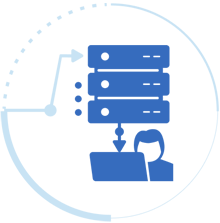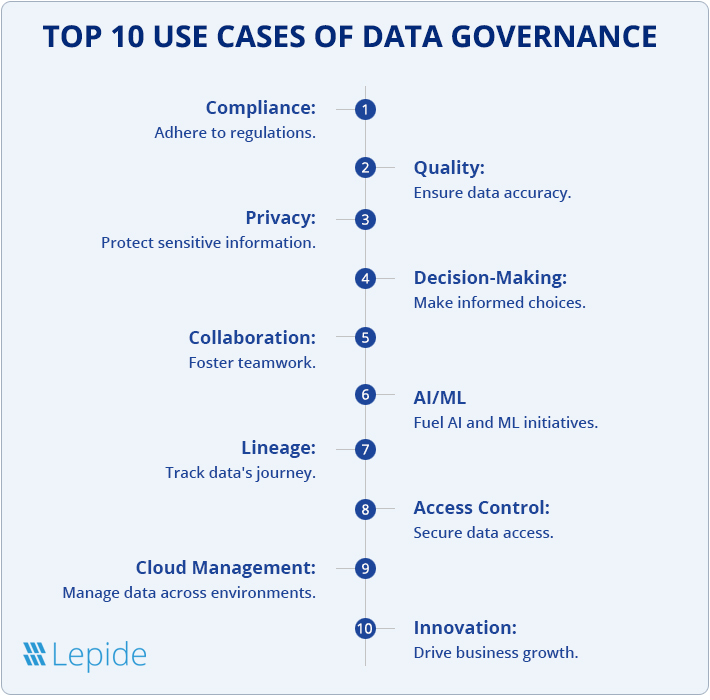Last Updated on December 11, 2024 by Satyendra

Businesses are generating and storing more information today than ever before, and there is an increasingly pressing (and mandated) need to manage and govern it. However, data governance is not all about avoiding penalties or organizing chaotic tables in Excel. Data governance is about how you can use data to open up new sources of value and revenue, make better decisions, and sometimes even build relationships with your clients.
In this blog, we will go through some of the key use cases for data governance, and why it matters.

Top 10 Data Governance Use Cases

1. Ensuring Regulatory Compliance
Regulatory compliance is all about ensuring that the behavior of applicable organizations is acceptable to managing authorities. When it comes to regulations such as GDPR, HIPAA, or CCPA, data governance is mandatory. These laws require very emphatic measures, especially on the capture, storage, and use of data. Lacking sound governance over the structure can lead to issues that might result in increased fines or a detrimental image.
Think of the possibility of having to search through a company that owns thousands of petabytes of data for every document relating to a European citizen who wants their data obscured from public view. Sounds daunting, right? Once an organization has a governance strategy in place, this data can easily be found and dealt with for compliance without much hassle.
2. Enhancing Data Quality
Bad data is like a bad joke, it doesn’t make people laugh and everyone is left in the dark. Poor quality data will result in wrong business decisions made, the organization not running optimally and customers may also be dissatisfied.
To some extent, data governance frameworks support the creation of norms in terms of the accuracy, consistency, or completeness of a given dataset. This means that the analytics team does not need to dedicate a lot of time to trying to clean the data and instead focus on how best to analyze the data for useful insights.
3. Supporting Data Privacy
Your customers often provide sensitive information, and they need to be sure that their sensitive data remains private. With data leaks occurring almost every week, privacy and ensuring that confidential information is safe should be a priority. Data governance can be effective in classifying personal and confidential data, to limit access to only authorized personnel.
For example, to make a healthcare information technology effective it must guarantee the patient’s file is open to only the medical professionals that need access. Encryption, role-based access, and audit trails are crucial components of a strong governance plan to address unauthorized access or misuse.
4. Using Reliable Data to Increase Decision-Making
Data governance is not only about compliance and limitations; it is more about enabling. When your team gets clean, reliable, well-documented data, they will be able to make better decisions in less time. For instance, consider a retail company choosing what products to order for the festive season. Through governed data, they are in a position to analyze trends especially on sales and customers instead of questioning the information they are presenting.
Decisions made with good data are like having a map and an alarm when going on a road trip; they may hit some potholes, but at least they do not wander off into the wilderness.
5. Facilitating Cross-Department Collaboration
Have you ever come across the phrase ‘left hand does not know what the right hand is doing”? This, in organizations, is particularly witnessed where teams do not have a coherent perspective of data. Data governance makes it easier to remove barriers that hamper cooperation and unite everyone under one roof.
For instance, the marketing team can use the same data set to calculate the marketing return on investment as the finance department can without a lot of confusion and hence the outcomes are better when the two are aligned. This makes it easier to collaborate since everyone is using the same “data language’.
6. Enabling AI and Machine Learning Initiatives
AI is only as good as the data it learns from. Garbage in, garbage out, as they say. Data governance ensures that datasets used in AI models are accurate, unbiased, and up-to-date. Consider a financial institution using AI to detect fraudulent transactions. Poor-quality or ungoverned data could lead to false positives or missed red flags. A governance framework ensures the AI system has the right training data to perform effectively. Remember, AI might be artificial, but its need for good data is 100% real.
7. Improving Data Lineage and Traceability
Data lineage is like a family tree for your datasets. It helps track where your data comes from, how it’s transformed, and where it ends up. This traceability is critical for audits, troubleshooting, and understanding the full lifecycle of your data.
For instance, when a manufacturing company notices a discrepancy in its supply chain data, a well-documented lineage can quickly pinpoint the source of the issue.
Ever played the game “telephone” as a kid? Without governance, your data could end up saying something completely different by the time it reaches the end.
8. Streamlining Data Access
Imagine walking into a library where every book is mislabeled. Governance is the librarian who makes sure everything is in its right place. Balancing data accessibility with security is tricky. On one hand, you want employees to access the data they need. On the other, unrestricted access can lead to security risks.
Data governance frameworks define clear policies for who can access what, when, and why. This reduces bottlenecks while ensuring sensitive information remains protected.
9. Supporting Cloud Data Management
As organizations migrate to the cloud, managing data across hybrid and multi-cloud environments has become increasingly complex. Data governance ensures seamless integration and control, regardless of where the data resides. For example, a global company with data centers in multiple countries must comply with regional data residency laws. Governance tools help automate these processes, reducing compliance risks and operational headaches. Whether on-premise or in the cloud, governance keeps your data grounded.
10. Driving Innovation and Business Value
Last but not least, effective data governance unlocks innovation. By making data more accessible, reliable, and actionable, organizations can identify new opportunities and stay ahead of competitors. Consider a logistics company using governed data to optimize delivery routes. Not only does this reduce costs, but it also improves customer satisfaction, creating a win-win scenario.
Why Data Governance Matters
Data governance might not have the flashy appeal of AI or blockchain, but it’s the unsung hero of the digital age. It builds trust, reduces risks, and turns chaotic datasets into a goldmine of insights. Whether you’re ensuring compliance or driving innovation, data governance is your best ally. Data without governance is like a library without bookshelves, chaotic, overwhelming, and a missed opportunity.
How Lepide Can Help
Lepide Data Security Platform is a powerful solution designed to help organizations establish and maintain resilient data governance practices. By automating key processes and providing comprehensive insights, Lepide helps organizations to:
- Discover and Classify Data: Identify sensitive data, classify it based on business value and regulatory requirements, and apply appropriate security controls.
- Monitor and Audit Data Access: Track user activity, detect anomalies, and enforce access policies to prevent unauthorized access.
- Enforce Data Policies: Automate policy enforcement and remediation actions to ensure compliance with data regulations.
- Generate Comprehensive Reports: Gain valuable insights into data usage patterns, identify possible risks, and demonstrate compliance.
If you’re ready to embrace data governance, start by identifying your organization’s unique needs and aligning them with these use cases. After all, the more governed your data, the better your decisions, and isn’t that the ultimate goal?
If you want to know more about how Lepide can help your organization in data governance, feel free to schedule a demo with one of our engineers today.

 Group Policy Examples and Settings for Effective Administration
Group Policy Examples and Settings for Effective Administration 15 Most Common Types of Cyber Attack and How to Prevent Them
15 Most Common Types of Cyber Attack and How to Prevent Them Why AD Account Keeps Getting Locked Out Frequently and How to Resolve It
Why AD Account Keeps Getting Locked Out Frequently and How to Resolve It
